Sage, White (Salvia apiana) Native
Sage, White (Salvia apiana)
This species is native!
Parts used: leaves, seeds
Medicinal uses: It can be made into a tea, which decreases sweating, salivation, and mucous secretions in the sinuses, throat, and lungs. Cold tea can be a good stomach tonic, while a lukewarm tea is good for treating sore throats. The leaves can also be used as a uterine hemostatic tea for heavy menstruation; however, since it can also decrease lactation, nursing mothers are advised not to use it.
Additional uses: Native Americans used white sage in the following ways: seeds were ground into a flour and used for mush; leaves were used for flavoring in cooking; leaves were also eaten, smoked or used in a sweathouse as a remedy for colds; seeds were dropped into the eye and permitted to roll around under the eyelids in order to cleanse the eyes; and leaves were crushed and mixed with water to create a hair shampoo, dye and straightener. The leaves and stems are also used in traditional “smudge” sticks that are used ceremonially to cleanse an area of negative energy (http://en.wikipedia.org/wiki/White_sage).
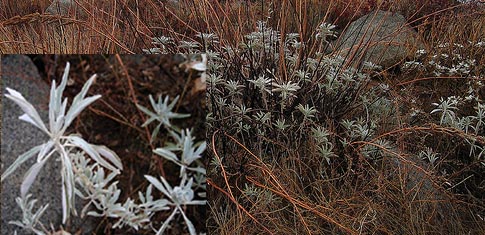
Pacific Northwest Medicinal Plant Guide (Check out all plants growing in Tryon Farm's medicinal garden!)
- Login to post comments



Sage, Garden (Salvia officinalis) and Purple (Salvia off. var. purpurascens) Non-Native
Sage (Garden (Salvia officinalis) and Purple (Salvia off. var. purpurascens))
Both species are non-native to Portland OR
Parts used: aerial portions
Medicinal uses: Remedy against gingivitis and mucosal inflammation of the mouth and throat. Also used as a digestive medicine to treat upset stomachs, flatulence and diarrhea. Also treats night sweats and excessive perspiration. Used as an anti-diabetic and as a culinary herb.
Additional uses: This plant is well known for its culinary uses. Traditionally this plant has been used as an ingredient in perfumes, soaps, and cosmetics. It is also used as an insect repellent. The plant attracts bees and makes a splendid honey. The dried leaves can be used in flower and herb arrangements. Sage tops yield a yellow-buff color to wool mordanted with alum, yellow with a chrome mordant and a green-gray color with an iron mordant (Kowalchik 441-2).
Cautions: Do not take essential oil internally. Best if avoided by nursing mothers as it can dry up the milk supply.
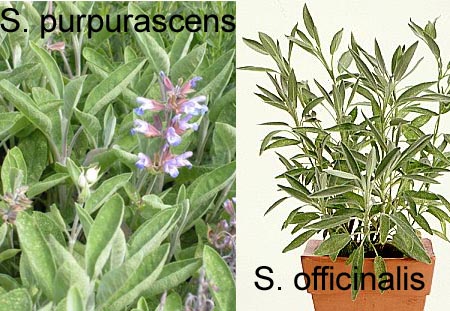
Pacific Northwest Medicinal Plant Guide (Check out all plants growing in Tryon Farm's medicinal garden!)
- Login to post comments



Rue (Ruta graveolens) Non-Native
Rue (Ruta graveolens)
Parts used: aerial portions
Medicinal uses: To treat menstrual disorders, spasms, loss of appetite, dyspeptic complaints, circulatory disorders, fever, high blood pressure, heart palpitations, inflamed mucosa, toothache, hysteria, arthritis, sprains, injuries, and skin diseases. Also used as a uterine stimulant, and formerly used to improve and stabilize wine of bad quality (Chevallier 364).
Additional uses: The dried seed heads can be used in flower and herb arrangements. Tradition states that rue should not be planted near basil, sage, or cabbage, though it is said to enhance the growth of figs (Kowalchik 434-5)
Cautions: Can be toxic if taken in excess. Never take during pregnancy. Fresh plant can cause dermatitis. If taken internally, can cause an allergic skin reaction to sunlight (Chevallier 264).
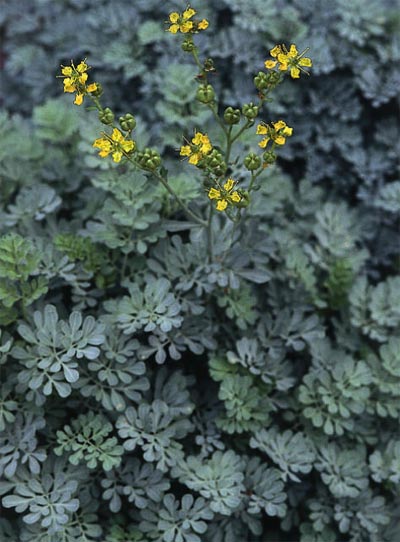
Pacific Northwest Medicinal Plant Guide (Check out all plants growing in Tryon Farm's medicinal garden!)
- Login to post comments



Rosemary (Rosmarinus officinalis) Non-Native
Rosemary (Rosmarinus officinalis)
Parts used: aerial portions
Medicinal uses: Tonic, stimulant, astringent, nervine, anti-inflammatory, carminative; tincture, tea, eat raw; classic digestive, nerve and circulatory tonic; treatment for low energy, low blood pressure, poor circulation; improves memory, gives courage, lifts spirits; rub tincture, tea, or leaves onto areas of poor circulation; rub onto chest to stimulate weak heart; bath can be used as a circulation stimulant; diaphoretic—promotes sweating; essential oil or strong tincture discourages lice
Additional uses: This plant is well known for its culinary uses. A strongly aromatic plant it can be used in sachets to scent clothing, while an infused oil can be added to many skin care products. As a dye plant rosemary can be used to achieve a variety of yellow-green shades with different mordants (Kowalchik 432).
Cautions: Avoid daily use of strong extracts during pregnancy. Avoid direct contact with eyes, sensitive skin, mucous membranes.
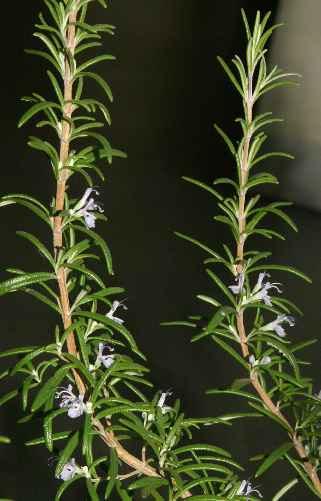
Pacific Northwest Medicinal Plant Guide (Check out all plants growing in Tryon Farm's medicinal garden!)
- Login to post comments



Rose, Japanese (Rosa rugosa) Non-Native
Rose, Japanese (Rosa rugosa)
Parts used: hips
Medicinal uses: The hips are high in vitamin C, B, E, and K (Kowalchik 427).
Additional uses: Flowers are used to make a sweet smelling potpourri in Japan and China.
Cautions: None stated
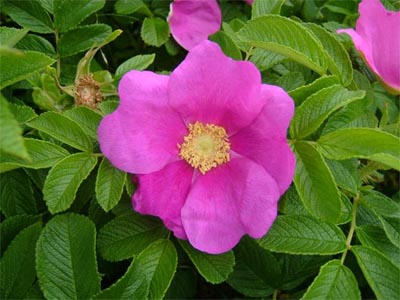
Pacific Northwest Medicinal Plant Guide (Check out all plants growing in Tryon Farm's medicinal garden!)
- Login to post comments



Red currant (Ribes rubrum) some varieties are native
Red currant (Ribes rubrum) some varieties
Parts used: berries, leaves
Medicinal uses: The fruit is antiscorbutic, aperient, depurative, digestive, diuretic, laxative, refrigerant and sialagogue. The leaves contain the toxin hydrogen cyanide. A decoction of them is used externally to relieve rheumatic symptoms. As a poultice it can relieve sprains or reduce the pain of dislocations.
Other uses: Red currants are often used to make jams and jellies as well as some sauces. They have a tart, sour flavor. A yellow dye is obtained from the leaves. A black dye is obtained from the fruit. The fruit is used cosmetically in face-masks for firming up tired and lifeless skin (www.ibiblio.org/pfaf/cgi-bin/arr_html?Ribes+rubrum).
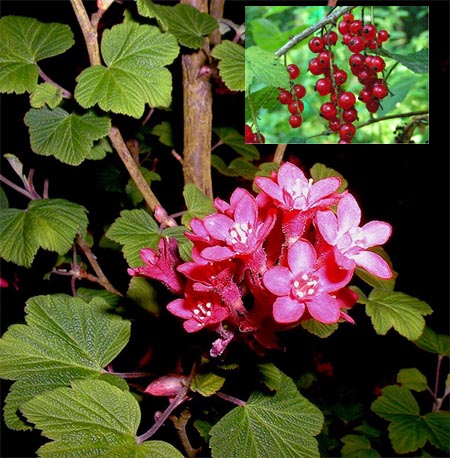
Pacific Northwest Medicinal Plant Guide (Check out all plants growing in Tryon Farm's medicinal garden!)
- Login to post comments



Raspberry (Rubus idaeus) Native and Non-Native Varieties
Raspberry (Rubus idaeus)
Parts used: leaf, fruit
Medicinal uses: For their astringent properties, to treat diarrhea and as a gargle for mouth or throat infections, and as an ingredient in teas. Also tones the uterus helping to ease labor in childbirth.
Nutritional information: Raspberries are an excellent source of fiber, manganese, vitamin C, flavonoids, and ellagic acid. They are a very good source of vitamin B2 as well as a good source of other B vitamins, such as folic acid, niacin, pantothenic acid, and vitamin B6 (Murray 312).
Cautions: Some recommend not taking raspberry leaf medicinally during the early stages of pregnancy. Others recommend the use of this tonic plant throughout pregnancy (Chevallier 263, Gladstar, Romm).
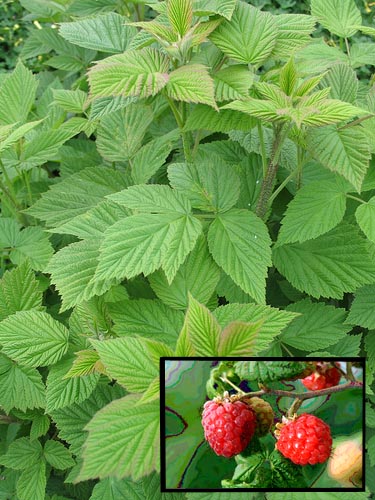
Pacific Northwest Medicinal Plant Guide (Check out all plants growing in Tryon Farm's medicinal garden!)
- Login to post comments



Poppy (Papaver rhoeas) Non-Native
Poppy (Papaver rhoeas)
Parts used: flowers
Medicinal uses: This entry focuses on the uses of the corn or field poppy rather than its more notorious relative the opium poppy (P. somniferum). The flowers are mildly analgesic and sedative and have been used extensively throughout Europe for ailments of children and the elderly. It is used chiefly as a mild pain reliever and as a treatment for irritable coughs, it also reduces nervous over-activity. The herb may also be used for insomnia, nervous irritability, coughs, and asthma (Chevallier 243).
Additional uses: The poppy seeds are often used in culinary applications. The flowers have been used in the past to color wines and medicines (Bremness 263).
Cautions: Use only under professional supervision. All parts of this plant aside from the seeds are potentially toxic if eaten (Chevallier 243).
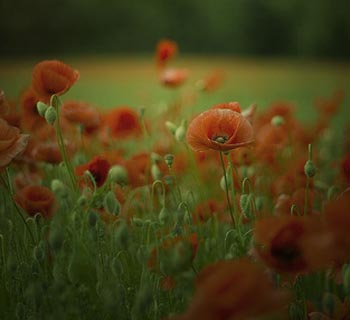
Pacific Northwest Medicinal Plant Guide (Check out all plants growing in Tryon Farm's medicinal garden!)
- Login to post comments



Plum (Prunus domestica) Native
Plum (Prunus domestica)
Parts used: fruit
Nutritional information: plums are a very good source of vitamin C. They are also a good source of vitamins B1, B2, and B6, phenolic compounds, and dietary fiber (Murray 306).
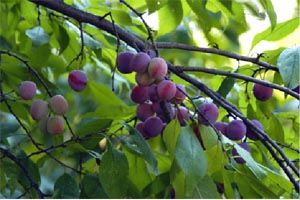
Pacific Northwest Medicinal Plant Guide (Check out all plants growing in Tryon Farm's medicinal garden!)
- Login to post comments



Plantain, common (Plantago major) and Ribwort plantain (Plantago lanceolata) Non-Native
Plantain, common (Plantago major) and Ribwort plantain (Plantago lanceolata)
Parts used: leaves
Medicinal uses: Quickly staunches blood flow and encourages the repair of damaged tissue. It can be used to treat bruises and broken bones. An ointment or lotion can be used to treat hemorrhoids and external ulcers. Taken internally it is diuretic, expectorant, and decongestant. It is commonly used for gastritis, peptic ulcers, diarrhea, dysentery, irritable bowel syndrome, respiratory congestions, loss of voice, and urinary tract bleeding (Chevallier 250-1). The leaves themselves can be used immediately to staunch wounds and abrasions in the field, often termed nature’s bandage. Just bruise the lead slightly then wrap around the damaged tissue.
Additional uses: An infusion of the plant can be used as a skin lotion. Using the whole plant, wool can be died a dull gold with an alum mordant. If a chrome mordant is used then a camel color can be found (Kowalchik 416).
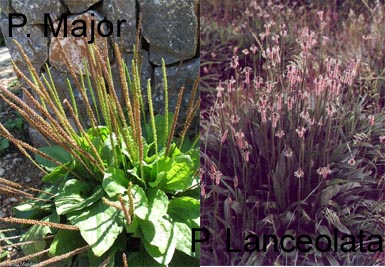
Pacific Northwest Medicinal Plant Guide (Check out all plants growing in Tryon Farm's medicinal garden!)
Cautions: None known (Chevallier 250-1)
- Login to post comments



Feedback and participation welcome! Please send bug reports to web@tryonfarm.org








